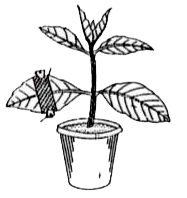For conducting girdling experiments
the cortex is removed
the cortex and primary phloem and removed
all tissues upto secondary xylem are removed
none of the above
The correct Answer is:C
To solve the question about conducting girdling experiments, we need to understand what girdling is and what it entails.
1. Understand Girdling: Girdling is a technique used to study the transport of nutrients and water in plants. It involves removing a ring of bark from around the trunk of a tree or woody plant.
2. Identify the Components Involved: The bark of the tree contains the phloem, which is responsible for the transport of food (sugars) produced by photosynthesis. The xylem, located beneath the phloem, is responsible for the transport of water and minerals.
3. Determine What is Removed: In a girdling experiment, the removal of the bark (which includes the phloem) is essential. Depending on the depth of the girdle, it may also involve the removal of some surrounding tissues.
4. Analyze the Options:
- Option A: The cortex is removed. (Partially correct, but doesn't specify the phloem)
- Option B: The cortex and primary phloem are removed. (More accurate as it includes phloem)
- Option C: The tissue up to secondary xylem is removed. (This is the most accurate as it indicates that the phloem and some surrounding tissues are removed)
- Option D: None of the above. (Incorrect as there are valid options)
5. Select the Correct Answer: Based on the analysis, the correct answer is Option C, as it indicates that all tissues up to the secondary xylem are removed, which is necessary for the girdling experiment to demonstrate the role of phloem in translocation.
Final Answer:
Option C: The tissue up to secondary xylem are removed.
---
- Option A: The cortex is removed. (Partially correct, but doesn't specify the phloem)
- Option B: The cortex and primary phloem are removed. (More accurate as it includes phloem)
- Option C: The tissue up to secondary xylem is removed. (This is the most accurate as it indicates that the phloem and some surrounding tissues are removed)
- Option D: None of the above. (Incorrect as there are valid options)
Option C: The tissue up to secondary xylem are removed.
Topper's Solved these Questions
Similar Questions
Knowledge Check
Ringing/girdling experiments demonstrate
Aphloem is responible for translocation of foodBXylem is responsible for ascent of sapCTranspiration pullDBoth (a) and (b)
On which plants did Darwin and Francis conduct their experiments ?
View SolutionThe diagram below represents an experiment conducted to prove the importance of a factor in photosynthesis
Study the same and then answer the questions that follow

Why was the plant kept in a dark room before conducting the experiment
View SolutionRinging (girdling) experiment cannot be performed in
View SolutionRinging/girdling experiment was first performed by
View SolutionMendel conducted hybridization experiments on Garden Pea of
View Solution[A]: Ringing/Girdling experiments involved removal of all tissues outside endodermis from a woody stem.
[R]: The upper & lower part of the plant is at- tached by central xylem & phloem.
View SolutionWhich of the following conclusions can be drawn from the girdling experiment?
View Solution
